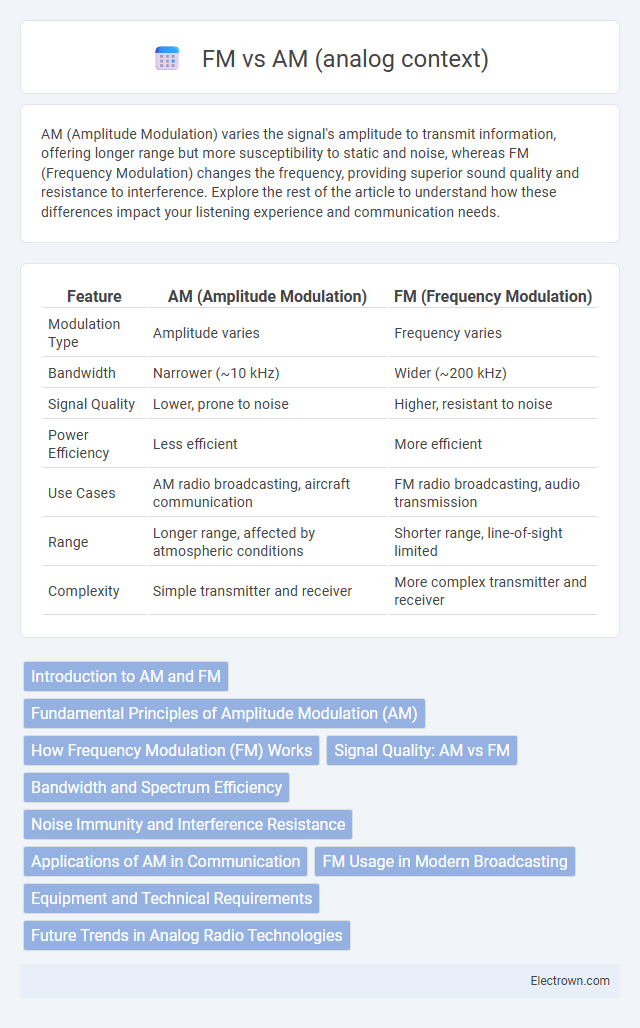AM (Amplitude Modulation) varies the signal's amplitude to transmit information, offering longer range but more susceptibility to static and noise, whereas FM (Frequency Modulation) changes the frequency, providing superior sound quality and resistance to interference. Explore the rest of the article to understand how these differences impact your listening experience and communication needs.
Table of Comparison
| Feature | AM (Amplitude Modulation) | FM (Frequency Modulation) |
|---|---|---|
| Modulation Type | Amplitude varies | Frequency varies |
| Bandwidth | Narrower (~10 kHz) | Wider (~200 kHz) |
| Signal Quality | Lower, prone to noise | Higher, resistant to noise |
| Power Efficiency | Less efficient | More efficient |
| Use Cases | AM radio broadcasting, aircraft communication | FM radio broadcasting, audio transmission |
| Range | Longer range, affected by atmospheric conditions | Shorter range, line-of-sight limited |
| Complexity | Simple transmitter and receiver | More complex transmitter and receiver |
Introduction to AM and FM
AM (Amplitude Modulation) transmits audio signals by varying the signal's amplitude while keeping frequency constant, making it susceptible to static interference but suitable for long-distance broadcasts. FM (Frequency Modulation) encodes audio by varying the frequency of the carrier wave, offering superior sound quality and noise resistance, especially in urban areas. Both methods utilize analog waveforms but differ fundamentally in signal modulation techniques and transmission characteristics.
Fundamental Principles of Amplitude Modulation (AM)
Amplitude Modulation (AM) operates by varying the amplitude of a high-frequency carrier wave in direct proportion to the instantaneous amplitude of the baseband audio signal, enabling the transmission of voice and music over long distances. The modulated signal consists of a carrier frequency plus two symmetrical sidebands that carry the information, occupying a bandwidth twice that of the original baseband signal. AM's fundamental principle relies on the linear modulation of amplitude while maintaining constant frequency and phase, which simplifies transmitter and receiver design but limits noise immunity compared to frequency modulation (FM).
How Frequency Modulation (FM) Works
Frequency Modulation (FM) works by varying the frequency of the carrier wave in direct proportion to the amplitude of the input signal, preserving the original sound information with less interference compared to Amplitude Modulation (AM). This modulation technique provides improved sound quality and noise resistance by making the signal less susceptible to amplitude variations caused by electrical noise or signal degradation. Your experience with FM radio benefits from clearer audio and reduced static, especially in environments with fluctuating signal strength.
Signal Quality: AM vs FM
FM (Frequency Modulation) signals provide superior sound quality compared to AM (Amplitude Modulation) because FM is less susceptible to static interference from electrical equipment and atmospheric conditions. AM signals vary in amplitude, making them more prone to noise and signal degradation, resulting in lower fidelity and clarity. FM's technique of encoding information in frequency changes enhances audio fidelity, especially for music and high-quality broadcasts.
Bandwidth and Spectrum Efficiency
AM (Amplitude Modulation) typically requires a narrower bandwidth of about 10 kHz per channel but is less spectrum-efficient due to its susceptibility to noise and interference. FM (Frequency Modulation) uses a wider bandwidth, approximately 200 kHz per channel, which allows for higher fidelity and better noise resistance, enhancing overall audio quality. Your choice between AM and FM should consider the trade-off between bandwidth consumption and audio clarity within the available spectrum.
Noise Immunity and Interference Resistance
FM (Frequency Modulation) offers superior noise immunity compared to AM (Amplitude Modulation) due to its encoding of information in frequency variations rather than amplitude, which is more susceptible to static and electrical interference. This difference results in FM providing clearer sound quality and greater resistance to atmospheric and man-made noise, making it ideal for music and high-fidelity audio transmission. When choosing a radio system for environments with significant electromagnetic interference, your best option is FM broadcasting, as it maintains signal integrity better than AM.
Applications of AM in Communication
AM (Amplitude Modulation) is widely used in long-distance radio broadcasting, especially for AM radio stations transmitting talk shows, news, and emergency information due to its ability to travel over large areas and penetrate obstacles. Aviation communication relies on AM for air-to-ground and ground-to-air radio transmissions, ensuring clear and reliable contact between pilots and air traffic controllers. Your communication benefits from AM's simplicity and compatibility with older analog devices, making it essential in specific legacy and emergency communication systems.
FM Usage in Modern Broadcasting
FM broadcasting dominates modern analog radio due to its superior sound quality and resistance to signal interference compared to AM. It operates within the 88 to 108 MHz frequency band, offering stereo sound and higher fidelity audio ideal for music and speech transmission. FM's frequency modulation technique ensures consistent audio clarity, making it the preferred choice for contemporary radio stations and urban markets.
Equipment and Technical Requirements
AM and FM radios require different technical equipment due to their signal modulation methods; AM (Amplitude Modulation) radios utilize simpler circuits that modulate the amplitude of the carrier wave, making them more susceptible to noise and interference but easier to manufacture. FM (Frequency Modulation) radios demand more complex hardware, including frequency discriminators and phase-locked loops, to decode the frequency variations, resulting in better sound quality and resistance to static. Your choice of equipment should consider these technical requirements and the intended application environment to ensure optimal performance.
Future Trends in Analog Radio Technologies
Future trends in analog radio technologies emphasize enhanced AM and FM transmission stability through improved modulation techniques and noise reduction algorithms. Innovations in hybrid radio systems are emerging, combining analog radio with digital metadata to enrich listener experience without requiring full digital transition. Continued investment in advanced analog receiver sensitivity and selectivity aims to maintain competitive audio quality and coverage resilience amidst growing digital alternatives.
AM vs FM (analog context) Infographic

 electrown.com
electrown.com